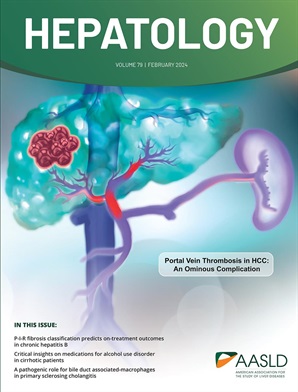Increased risk of hepatocellular carcinoma in HBeAg-negative indeterminate phase compared to HBeAg-negative chronic infection
IF 12.9
1区 医学
Q1 GASTROENTEROLOGY & HEPATOLOGY
引用次数: 0
Abstract
Background & Aims: The outcomes and benefits of antiviral therapy in patients with indeterminate phase HBeAg-negative chronic hepatitis B (CHB) are not well described in treatment guidelines. We examined hepatocellular carcinoma (HCC) risk among these patients. Approach & Results: We identified all non-cirrhotic treatment-naïve patients with HBeAg-negative CHB who received ≥1 test for hepatitis B virus (HBV) DNA and HBeAg. HBeAg-negative indeterminate phase included abnormal alanine aminotransferase (ALT ≥40 IU/L) and low HBV DNA (<2,000 IU/mL), or normal ALT (<40 IU/L) and high HBV DNA (≥2,000 IU/mL). Cox model evaluated relationship between HBV phase and HCC risk, with antiviral therapy as time-dependent variable. In 17,287 patients (mean age 54.1 years, 50% male), 4,071 (24%) transitioned to HBeAg-negative chronic hepatitis, 8,722 (50%) remained in the indeterminate phase, and 4,494 (26%) moved to HBeAg-negative chronic infection over a median follow-up of 55.1 [interquartile range 21.3-105.4] months. Patients in the indeterminate phase had a significantly higher HCC risk than those in chronic infection (adjusted hazard ratio [aHR] 1.587, 95% CI 1.262-1.995). Among patients in the indeterminate phase, those with normal ALT and high HBV DNA had a higher HCC risk than those with abnormal ALT and low HBV DNA (aHR 1.377, 95% CI 1.007-1.883,与hbeag阴性慢性感染相比,hbeag阴性不确定期肝细胞癌的风险增加
背景,目的:不确定期hbeag阴性慢性乙型肝炎(CHB)患者抗病毒治疗的结果和益处在治疗指南中没有很好的描述。我们检查了这些患者的肝细胞癌(HCC)风险。的方法,结果:我们确定了所有接受乙型肝炎病毒(HBV) DNA和HBeAg≥1检测的非肝硬化treatment-naïve HBeAg阴性CHB患者。hbeag阴性不确定期包括丙氨酸转氨酶异常(ALT≥40 IU/L)和低HBV DNA (< 2000 IU/mL),或ALT正常(<40 IU/L)和高HBV DNA(≥2000 IU/mL)。Cox模型评估HBV分期与HCC风险的关系,抗病毒治疗为时间相关变量。在17287例患者(平均年龄54.1岁,50%为男性)中,4071例(24%)过渡到hbeag阴性慢性肝炎,8722例(50%)仍处于不确定阶段,4494例(26%)在中位随访55.1个月[四分位数间距21.3-105.4]个月期间转移到hbeag阴性慢性肝炎。不确定期患者发生HCC的风险明显高于慢性感染患者(校正风险比[aHR] 1.587, 95% CI 1.262-1.995)。在不确定期患者中,ALT正常、HBV DNA高的患者发生HCC的风险高于ALT异常、HBV DNA低的患者(aHR为1.377,95% CI为1.007 ~ 1.883,p=0.045)。两组患者的5年累积HCC发病率在治疗组和未治疗组之间无显著差异。结论:在不确定期hbeag阴性CHB患者中,ALT正常、HBV DNA高的患者发生HCC的风险高于ALT异常、HBV DNA低的患者,治疗组和未治疗组之间无差异。密切监测和及时抗病毒治疗可能足以降低未治疗患者的HCC风险。
本文章由计算机程序翻译,如有差异,请以英文原文为准。
求助全文
约1分钟内获得全文
求助全文
来源期刊

Hepatology
医学-胃肠肝病学
CiteScore
27.50
自引率
3.70%
发文量
609
审稿时长
1 months
期刊介绍:
HEPATOLOGY is recognized as the leading publication in the field of liver disease. It features original, peer-reviewed articles covering various aspects of liver structure, function, and disease. The journal's distinguished Editorial Board carefully selects the best articles each month, focusing on topics including immunology, chronic hepatitis, viral hepatitis, cirrhosis, genetic and metabolic liver diseases, liver cancer, and drug metabolism.
 求助内容:
求助内容: 应助结果提醒方式:
应助结果提醒方式:


